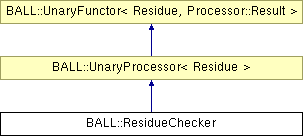ResidueChecker Class Reference
[Miscellaneous]
Residue Consistency Checker.
More...
#include <residueChecker.h>
Inheritance diagram for ResidueChecker:

Public Types | |
| enum | TestType { MISSING_ATOMS = 0, EXTRA_ATOMS, ELEMENTS, SUSPECT_BOND_LENGTHS, NON_INTEGRAL_NET_CHARGE, LARGE_CHARGES, LARGE_NET_CHARGE, NAN_POSITIONS, OVERLAPPING_ATOMS, STRONGLY_OVERLAPPING_ATOMS, DUPLICATE_ATOM_NAMES, UNKNOWN_RESIDUES, NUMBER_OF_TESTS } |
| Enum to refer to the individual tests. More... | |
Public Member Functions | |
| ResidueChecker () | |
| Default constructor. | |
| ResidueChecker (FragmentDB &fragment_db) | |
| Detailed constructor. | |
| ResidueChecker (const ResidueChecker &residue_checker) | |
| Copy constructor. | |
| virtual | ~ResidueChecker () |
| Destructor. | |
| void | enable (TestType t) throw () |
| Enable a specific test. | |
| void | disable (TestType t) throw () |
| Disable a specific test. | |
| void | enableSelection () throw () |
| Enable selection of problematic atoms. | |
| void | disableSelection () throw () |
| Disable selection of problematic atoms. | |
| bool | isSelectionEnabled () throw () |
| Return the status of the selection. | |
| bool | getStatus () const |
| Return true if the last application did not produce any warning. | |
| bool | isEnabled (TestType t) const throw () |
| Check whether a specific test is enabled. | |
| Processor::Result | operator() (Residue &residue) |
| operator () | |
| bool | start () |
| start method | |
| bool | finish () |
| finish method | |
Explicit tests | |
| bool | checkAtomPositions (const Residue &res, const String &res_name) throw () |
| bool | checkCharge (const Residue &res, const String &res_name) throw () |
| bool | checkCompleteness (const Residue &res, const Residue &reference, const String &res_name) throw () |
| bool | checkTemplate (const Residue &res, const Residue &reference, const String &res_name) throw () |
Protected Attributes | |
| FragmentDB * | fragment_db_ |
| bool | status_ |
| BitVector | tests_ |
| bool | selection_ |
Detailed Description
Residue Consistency Checker.This processor checks residues for internal consistency. It identifies missing or superfluous atoms, suspect bond lengths and non-integral or extremely large charges on the residue. Atom positions are checked as well: a warning is printed, if any of the atom's coordinates is not a number (NaN). Warnings are emitted to Log .
- The individual tests can be enabled/disabled using the enable and disable methods. Please use the enum TestTypes to refer to the appropriate tests. By default all tests are enabled except for OVERLAPPING_ATOMS.
-
missing atoms in a residue
This test checks whether all atoms contained in the fragment database for this type of residue are present in each of the residues.
-
extra atoms
This test checks whether all atoms contained in the current residue are also present in the template from the fragment database.
-
correct elements
Check that all atoms in a residue are of the same element as the corresponding atoms in the template from the fragment database.
-
suspect bond lengths
Check that the bond lengths encountered in each of the residues agree within 15% with the bond length in the template from the reference database.
-
non-integral net charge
Check that the sum of charges of a residue is integral, i.e. the sum of all charges is an integer (+/- 0.05 elementary charges).
-
large charges
Check that the none of the atoms bears a charge with an absolute value above 4.0 elementary charges.
-
large net charge
Check that the net charge of the residue is between -2 and +2 elementary charges.
-
NaN atom positions
Check whether any atom has NaN (not a number) as any of its corrdinates. This is a frequent source of error after failing simulations, minimizations, etc.
-
strongly overlapping atoms
Check whether any pair of atoms within a residue is closer than 0.5 Angstrom.
-
overlapping atoms
Check whether any pair of atoms not sharing a bond is further apart then the sum of their vdW radii minus 0.4 Ansgtrom
-
duplicate atom names
Check whether two atoms within the residue have the same name.
-
unknown residues
If unknown residues are encountered (i.e. residues for which no reference template exists in the fragment database), an error occurs. If this test is disabled, the tests requiring a template (missing atoms, extra atoms, suspectr bond lengths, elements) will not be executed for unknown residues.
Member Enumeration Documentation
|
|
Enum to refer to the individual tests. The values of this enum are used by enable , disable , and isEnabled . |
Member Function Documentation
|
|
Return true if the last application did not produce any warning. The getStatus method may be called after applying the ResidueChecker to a kernel object.
|